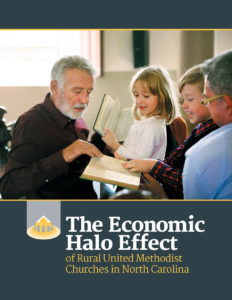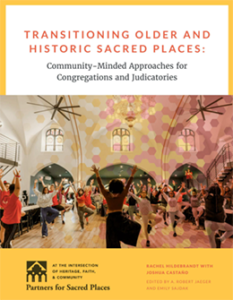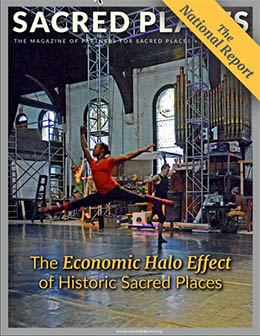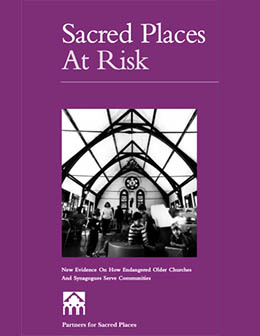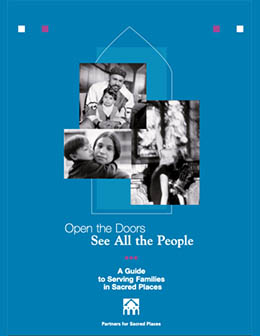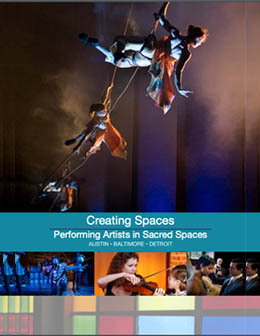Publications and Guides
Partners has been a research leader, defining and energizing the study of the public value of religious assets with our 1998 landmark study, Sacred Places at Risk: New Evidence on How Endangered Older Churches and Synagogues Serve Communities, and our 2016 study, Economic Halo Effect of Sacred PlacesSM. Thanks to these studies, which documented dozens of ways sacred places contribute to their communities and local economies, congregations around the country are able to advocate for increased community support.
Much of Partners’ research has been integrated into tools that congregations can use to maintain their building, make new community connections, and raise funds. Partners has also gathered a variety of informational resources on the care and active community use of older purpose built religious buildings. Congregations looking to address these needs are are encouraged to look through the pages and documents contained below, and elsewhere in the Information Center section of this website.
Electronic Publications
The Economic Halo Effect of Rural United Methodist Churches of North Carolina, published in December 2021, is the first statewide study of the economic impact of rural congregations. The study finds rural United Methodist congregations in North Carolina contribute $735,000 on the average to their towns and counties. Seventy-two percent of those benefiting from programs housed in UMC churches are not members of those congregations. In effect, rural Methodist churches are de facto community centers, just as their sister churches in cities.
Transitioning Older and Historic Sacred Places: Community-Minded Approaches for Congregations and Judicatories was published by Partners in 2021 to provide guidance and support to congregations as they consider transition of their properties. The Guide is a recognition that many religious buildings will be transitioned out of religious use in the years to come as congregations throughout the United States struggle to sustain themselves while also caring for aging buildings. The Guide is a welcome reference for faith and civic leaders who are eager for access to a resource that lays out a civic-minded approach to religious property – founded on the principle that older houses of worship have public value and are a meaningful presence in our communities.
Philadelphia’s Historic Places was a study by Penn Praxis, supported by Partners for Sacred Places and published by The Pew Charitable Trusts in 2017, to catalogue 839 existing historic sacred places in Philadelphia, and identify key factors of vulnerability and resilience that will help determine whether the buildings continue to be used for their original purpose or adapted for a new use. Learn more or read the study.
The Economic Halo Effect of Historic Sacred Places was a national research study of 90 congregations in three cities, published in 2016, to calculate the economic contribution of urban sacred places to their community – over $1.7 million per year! Learn more or read the study.
Creating Spaces was a study published in 2015, conducted with professor Neville Vakharia from Drexel University, in Austin, Detroit, and Baltimore, to answer the question: “Can a scalable, replicable program model be developed for sacred places to serve as homes to performing artists and small to midsize performing arts organizations, thereby providing much needed support to the sector, encouraging emerging artists, diversifying and expanding audiences, and supporting underserved communities?” Learn more or read the study.
Partners’ Guide to Serving Families, published in 2001, was shaped by focus group feedback from 43 congregations and community representatives in three cities. It is intended to advise and encourage congregations to develop their own facilities into vital, active centers that serve children and families.
Sacred Places at Risk was a national study of over 100 sacred places in six cities, conducted with Dr. Ram Cnaan from the University of Pennsylvania and published in 1998, that first documented the contributions that sacred places made to benefit the public at large. It played a key role in defining and energizing a nascent field of study on the public value of religious assets.
Publications Available only in Hard Copy
Partners’ Complete Guide to Capital Campaigns for Historic Churches and Synagogues is a valuable tool to guide congregations of all sizes through the steps of a community capital campaign. Guides are $57 each, including domestic shipping. Purchase a copy.
Web Guides
Looking for fundraising help? This fundraising guide offers basic advice to those who are just starting the process of raising money for capital needs or new programs.
Looking to share space? The Arts in Sacred Places program has put together a manual of best practices which covers many of the considerations that an artist or a sacred place should review before partnering with one another.
Want to keep your building in good shape? This repair and maintenance guide reminds you of the steps you can take to preserve your most important ministry asset.
Motivated to share your bounty? If you are interested in sharing your space with other groups, this community outreach and space-sharing guide offers ideas and helpful tips.
Want to read about model social service programs? Launched with support from the William Penn Foundation, the Exemplar Project sought to identify, spotlight, and build awareness of congregation-based programs and social services that are particularly innovative, affordable, and effective.
Convening Report
One of the most critical tools available to effective leaders and organizations is the power to convene. In April 2024, Partners for Sacred Places did just that when it gathered some 100 leaders from across the sectors of building preservation, architecture, philanthropy, faith communities, academia, government, and media to broaden a conversation they’ve been leading for 35 years. This summary report of the National Convening on “Activating Hidden Assets: Making the Most of Sacred Places for the Wider Community” offers a review of this exceptional gathering and a call to action for moving forward.

